Project Category: Mechanical
Join our presentation

About our project
Our project aims to improve the off-road handling of a Yamaha Kodiak by designing a hydropneumatic suspension system to replace its traditional suspension. The success of an off-road vehicle depends heavily on its ability to respond to the terrain it is being used on. Hence, the suspension design of this type of vehicle is extremely important. In most commercial off-road vehicles traditional spring and damper systems are used to provide suspension. However, these methods have inherent limitations due to their physical components. Hydropneumatic suspension was invented by Citroen and used in their commercial vehicles. It was found that vehicles with hydropneumatic systems handle exceptionally well on different road conditions. Traditional spring and damper systems have spring and damping characteristics that stay constant which will affect a vehicle’s performance especially in extreme conditions (e.g. off-road). In contrast, hydropneumatic suspension (which uses a combination of hydraulic and pneumatic systems) can vary the spring and damping characteristics depending on the road conditions.
Meet our team members

Ryan
Bruno
A mechanical engineering student currently working as the suspension design lead for the UofC Solar Car Team. Throughout his years in the team, he has garnered experience in composite manufacturing, aerodynamics theory, and suspension-related design; this experience brought about his interest in this capstone project. His enjoyment resides in baking, reading, fitness, and piano.

Angela
Le
Angela is currently finishing her fourth year of mechanical engineering with a biomedical specialization at the University of Calgary. She has a passion for understanding mechanical concepts and enjoys applying them to biomedical applications. During her free time, she enjoys planting and gardening, baking and cooking, skating, running, and reading.

Anh
Le
Anh is a Vietnamese international student and is currently finishing his 4th year of mechanical engineering at the University of Calgary. After a 2-month internship with a telecommunication company called Viettel, in their electromechanical department, he has developed skills in designing mechanical components. This project has expanded his interest further into designing analysis and mechanical systems. Furthermore, he has a special interest in the automotive industry and making games.

Ray
Hulog
Ray is a mechanical engineering student at the University of Calgary. He has always been fascinated with control systems in robotics and mechatronics. Besides working on his latest projects, he also enjoys writing his own music and sketching portraits.

Jeremiah
Padilla
Jeremiah is currently a fifth-year mechanical engineering student at the University of Calgary after completing a year-long internship at Peace River Hydro Partners in their quality department. This project allowed him to expand his mechanical design skills in SolidWorks and learn more about Simulink. Outside of his studies, he enjoys painting miniatures, fitness, reading, and photography.

Christina
Bueckert
Christina is a fourth year mechanical engineering student, with a biomedical specialization, at the University of Calgary. She is passionate about applying engineering concepts and skills in the biomedical field. She was able to spend two summers working on a biomedical research project that gave her the opportunity to put her academic knowledge to use in practical applications. Coffee keeps her going both in and outside of school and she also enjoys playing Ultimate frisbee and cooking.
Details about our design
WHY WE CHOSE HYDROPNEUMATIC SUSPENSION
Issues Encountered by Traditional Passive Suspension Systems
In this project, a Yamaha Kodiak suspension will be modified to mitigate issues that occur due to its traditional suspension. Its current suspension design involves the use of a mechanical spring and damper system. These components provide the constant spring rate and damping to the suspension. When this type of system faces extreme terrain irregularities it will often bottom out (i.e. the suspension system hits its limit). This occurs due to insufficient stroke length (i.e. the length of the cylinder) or insufficient damping and spring rates.
How Hydropneumatic Suspension Avoids these Issues
Hydropneumatic suspension is hailed for its exceptional performance on the road. Due to its varying spring constant and damping characteristics, it has the ability to adjust the suspension to the terrain and therefore allows it to keep the vehicle more stable and grip the road better than traditional suspension would. This ability for the suspension to adjust its operating conditions based on the terrain will be incorporated into our design in order to avoid issues with regular suspension such as bottoming out.
WHAT MAKES OUR DESIGN INNOVATIVE
Various types of hydropneumatic suspension exist but the one we use in our design will be an active hydropneumatic suspension. We will use electronic components to control and adjust the spring and damping characteristics of the suspension in response to the terrain. Using electronic components to help control the suspension will allow us great flexibility in our design and the ability to optimize the system for off-road use in a Yamaha Kodiak. This should allow us to create a suspension system with better performance than a traditional passive hydropneumatic suspension which is limited by its physical components.
WHAT MAKES OUR DESIGN SOLUTION EFFECTIVE
In a traditional suspension system, the stiffness of the spring and the damping characteristics of the damper providing the suspension are fixed, thus providing only passive suspension. In a hydropneumatic system, the spring and damping characteristics can be adjusted in response to the road conditions or driver input, maximizing ride comfort, tire grip, stability, etc. Our design is controlled by a PI-controller that detects the difference between the body/tire displacement and the road profile and automatically adjusts the spring and damping characteristics of the suspension system. By adjusting the spring and damping characteristics of the suspension based on the input from the terrain the off-road capabilities of the Yamaha Kodiak can be immensely improved.
VALIDATION OF OUR DESIGN SOLUTION
Hydraulic Schematic & SolidWorks Model
Our final design solution was initially represented using a hydraulic schematic. Once this schematic was completed the first method of design validation that our team used was the creation of CAD models. The major components of the hydraulic suspension system were modelled in SolidWorks. By modelling the parts we had chosen for our hydropneumatic suspension system in this 3D environment we were able to ensure that all the components could be successfully integrated with one another and also that the final design fit within the constraints of the Yamaha Kodiak.

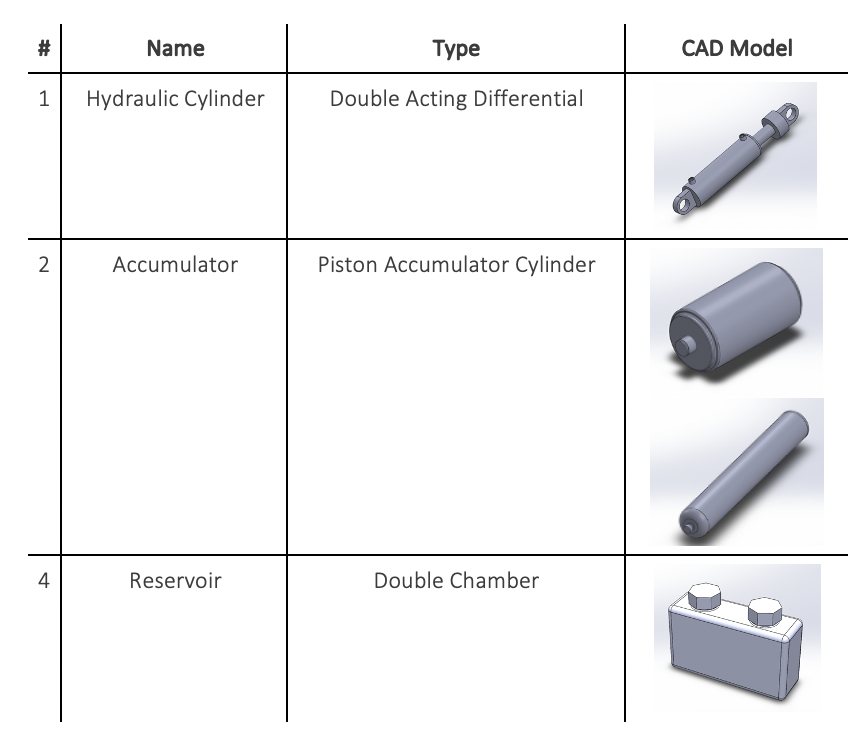
Simulation in MATLAB Simulink
In order to test whether our automated suspension system actually improved the system’s response to rough terrain a multi-domain physical system (i.e. mechanical, hydraulic, and electrical components) “prototype” of our design was built using Simscape within the Simulink environment. To determine whether or not the design had improved upon the traditional suspension a Simscape model of the original mechanical suspension system was also built in Simulink so that the performance of the two suspensions could be compared.

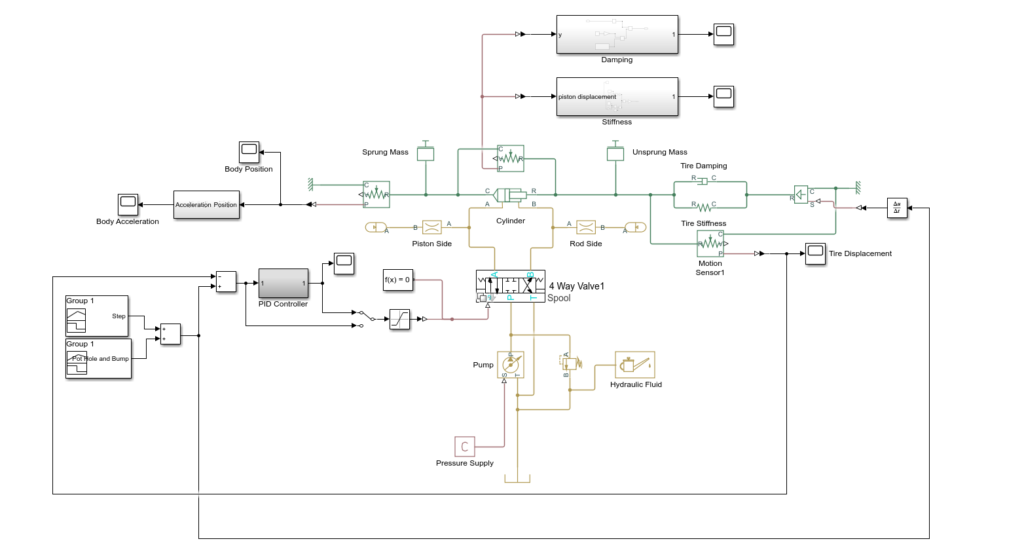
These suspension systems were then tested on different “road conditions” by using a displacement signal representing a road profile as the input for the model. The input signal used is shown below along with the tire position of the quad in response to this input using the two suspension systems.



This allowed us to observe how each suspension system reacted to and recovered from being exposed to different road conditions. The reaction and recovery of the hydropneumatic suspension system was then compared to that of the traditional suspension system.
FEASIBILITY OF OUR DESIGN SOLUTION
Based on our Simulink model, our design is theoretically sound and did provide a noticeable increase in the performance of our 2008 Yamaha 450 ATV. The tests done in the simulation showed an overall decrease in the magnitude of the shock experienced from disruptions in the road (i.e. rough off-road terrain) and faster overall recovery from these disruptions than a traditional suspension system. This design feasibility shows that it can be applied to other vehicles subjected to rough terrain conditions.
The CAD model provides a basis for the component dimensions, position, and integration into a 4×4 offroad ATV.
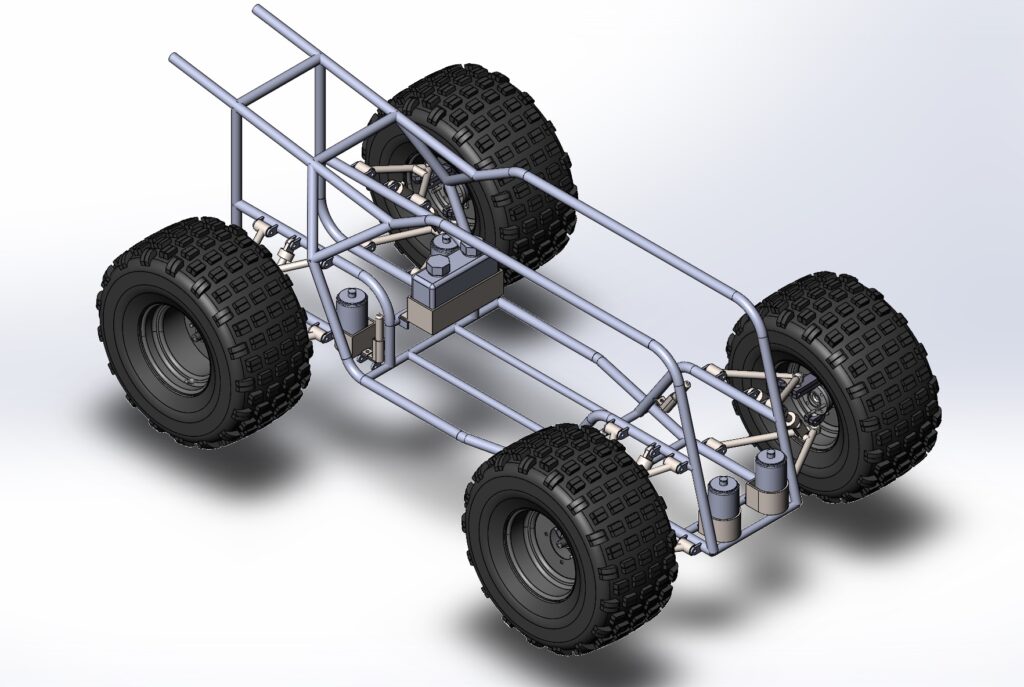
Partners and mentors
We want to thank the many people who helped us with this project. Our mechanical engineering professors Dr. Simon Li and Dr. Philip Egberts guided us through the process with patience and great advice. And, to our sponsor Darcy Funk for sharing his experience and knowledge with us over this past year and for all his support and guidance.
Our photo gallery
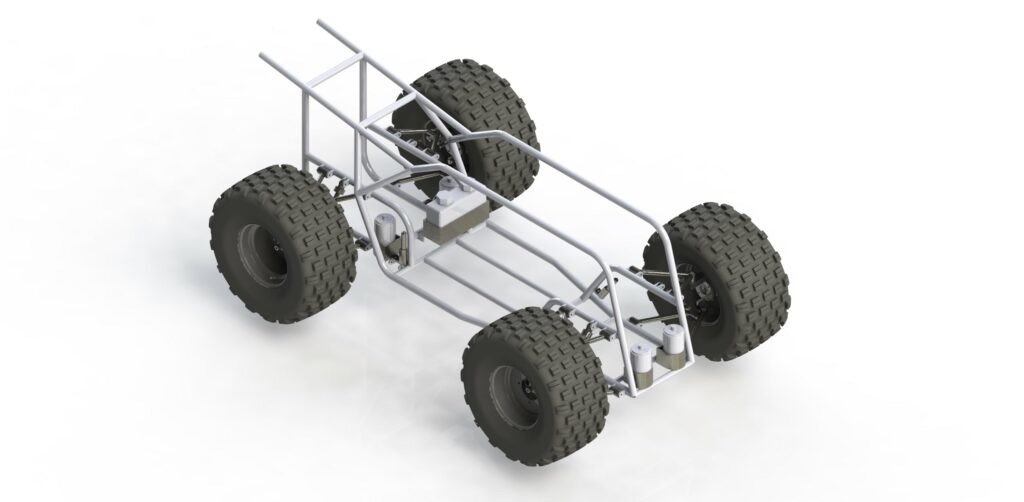
Rendering of Yamaha Kodiak chassis with automated hydropneumatic suspension system 
Simulink Model of Traditional Suspension System 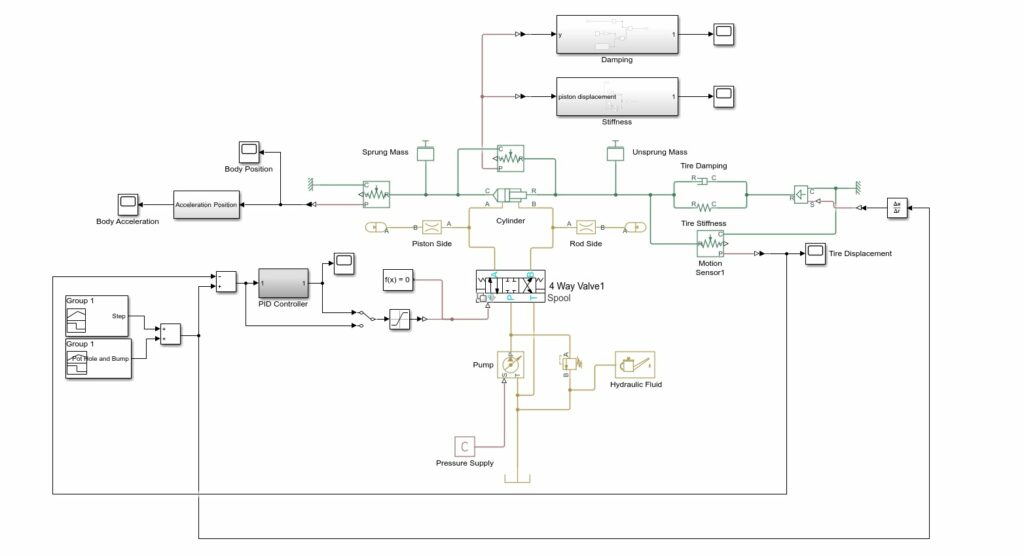
Simulink Model of Automated Hydropneumatic Suspension System 
SolidWorks model of Yamaha Kodiak chassis with automated hydropneumatic suspension system 
Displacement of body and tire over time using traditional (passive) suspension system model 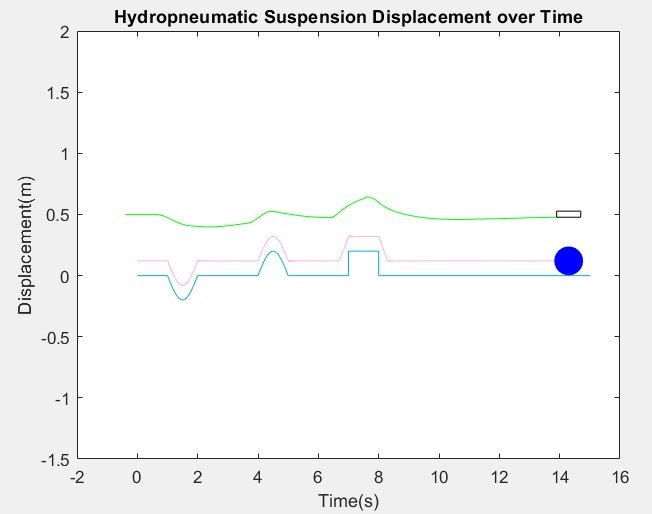
Displacement of body and tire over time using hydropneumatic suspension system model 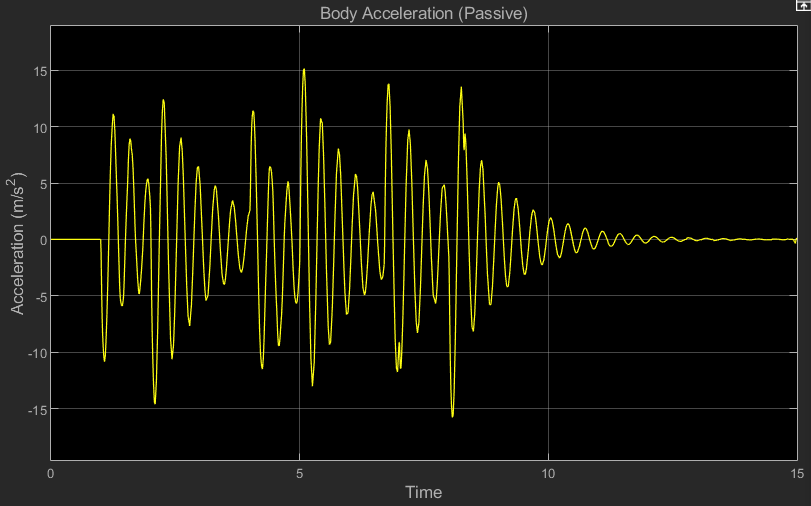
Body acceleration using passive (traditional) suspension system model 
Body acceleration using hydropneumatic suspension system model 
Body and tire position using automated suspension system model 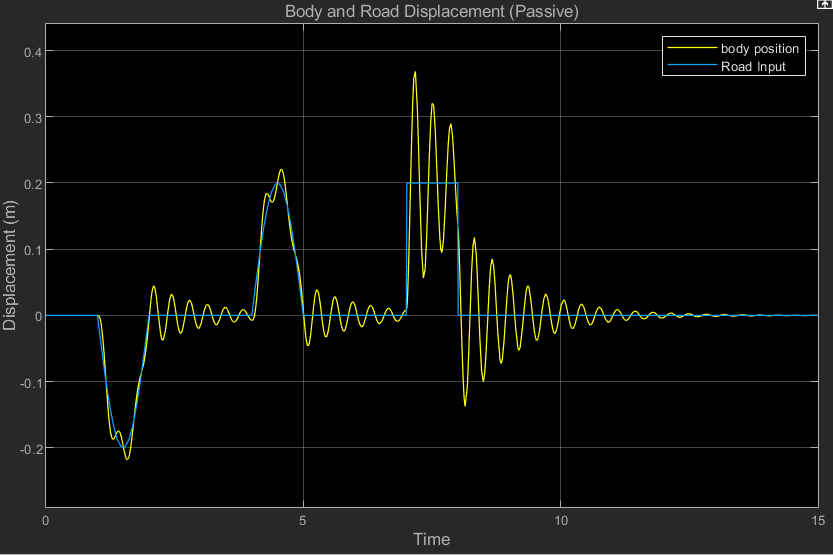
Body displacement in response to road profile input using passive suspension system model 
Body displacement in response to road profile input using hydropneumatic suspension system with no PID model 
Body displacement in response to road profile input using hydropneumatic suspension system with PID model 
Tire displacement in response to road displacement using passive suspension system model 
Tire displacement in response to road displacement using hydropneumatic suspension system model 
Variable damping in automated system model 
Variable stiffness in automated system model
